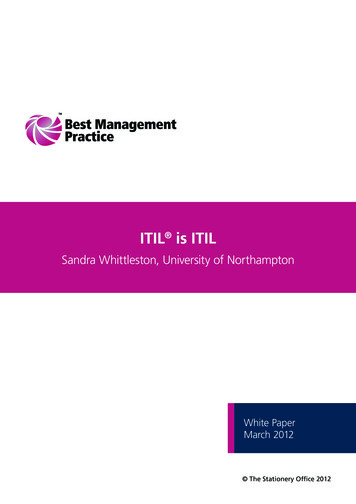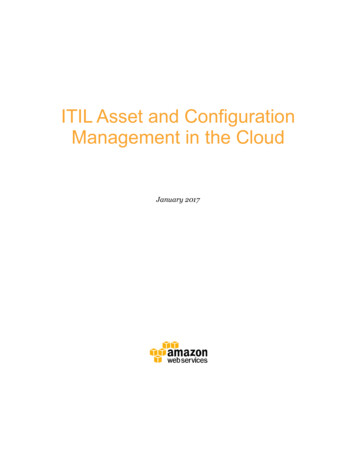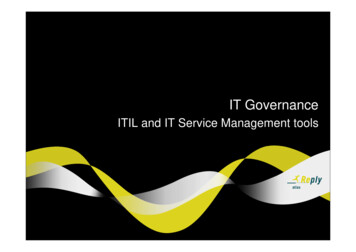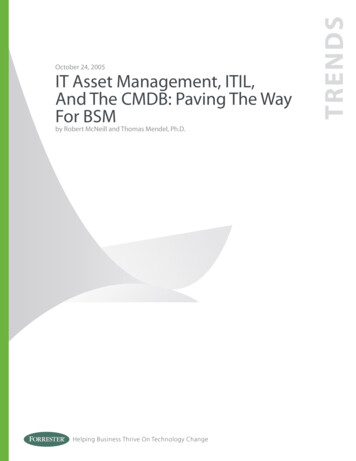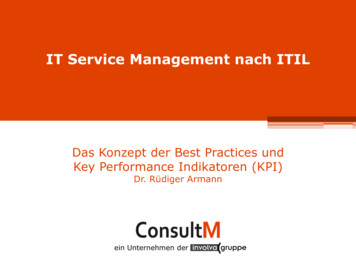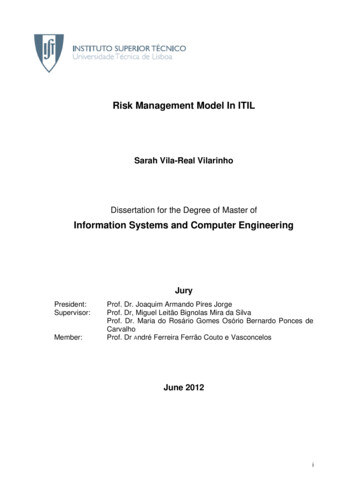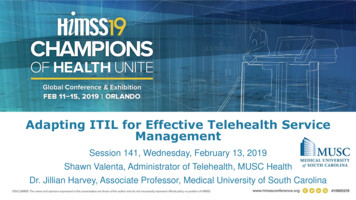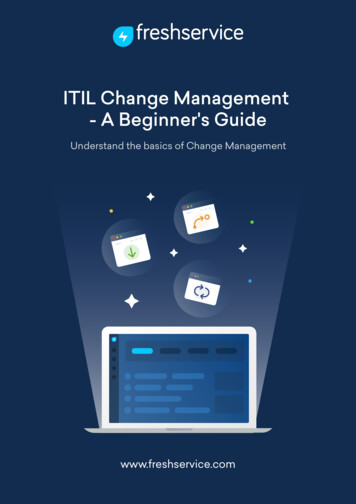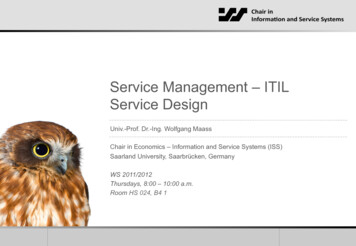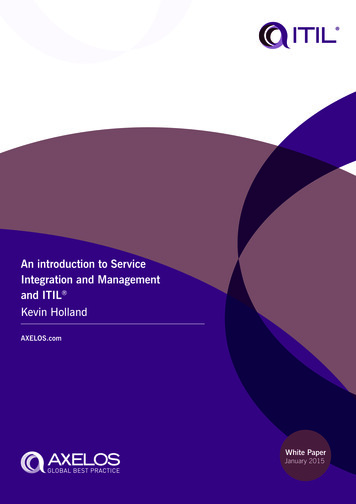
Transcription
An introduction to ServiceIntegration and Managementand ITIL Kevin HollandAXELOS.comWhite PaperJanuary 2015
ContentsForeword3Introduction4Models for SIAM7Principles and considerations9The benefits and investment objectives of SIAM15When should you consider using a SIAM model?17Sourcing strategy for SIAM19Governance of SIAM22Transition to new SIAM operating models22About the author24About AXELOS24Acknowledgments24Trade marks and statements24
An introduction to Service Integration and Management and ITIL ForewordITIL has always, quite rightly, promoted the primary importance of managing the end to end servicethat IT delivers to their customers. The increasing complexity of the IT value chain and the rise ofmulti‑vendor supplier eco-systems has led to the rise of Service Integration and Management (SIAM)as a new approach.SIAM is a relatively new and fast evolving concept, but it is far from being theoretical. SIAM teamsare being established as part of some of the largest strategic sourcing initiatives around the world andacross many different sectors.In this White Paper, Kevin Holland cogently argues that a successful implementation of SIAM restsupon the guidance provided by ITIL while also highlighting the need to adopt and adapt the guidance itcontains to reflect the multi-tenant model. He also provides an overview of the drivers for developing aSIAM strategy and the specific challenges that it generates. A second White Paper, An example modelfor effective Service Integration and Management describes one example model for SIAM.As Kevin states in this White Paper the IT industry has yet to develop an authoritative model fordescribing SIAM, and the objective evidence does not yet exist to reliably assess whether any specificoption for SIAM is more or less effective.However, the two White Papers are a major step forward in the global, industry-wide dialogue thatneeds to precede the development of an authoritative set of SIAM guidance.James Finister, Tata Consultancy Services3
4An introduction to Service Integration and Management and ITIL 1IntroductionThe purpose of this White Paper is to introduce the concepts for an effective way of managing servicesin a multi-supplier environment. It identifies the benefits of adopting a Service Integration andManagement (SIAM) based approach, and how ITIL provides the foundations for best practice.This paper is intended for: IT service management (ITSM) professionals already using ITIL in a multi-supplier environment ITSM professionals who understand ITIL and its benefits, and want to adopt ITIL for theirmulti-supplier management requirements IT service providers (internal and external to a business) SIAM providers SIAM consultants ITSM consultants.There are a number of challenges to planning and designing for SIAM, including: A general lack of published detailed best practice for SIAM No common understanding of what SIAM is and is not No common terminology (SIAM, MSI, SI, SI&M, etc.) Lack of understanding of the application of ITIL to SIAM Misconceptions about when SIAM is required A selection of the most appropriate sourcing model for SIAM A lack of available models for managing SIAM performance Ensuring improvements in service quality, while at the same time reducing costs A historic tendency to manage suppliers activities instead of outcomes.These challenges result in: Some businesses who could benefit from SIAM are missing the opportunity Some businesses are adopting SIAM but are failing to achieve the benefits.This White Paper will help to address these challenges by providing an introduction to the subject andsome practical guidance on how to make SIAM work.The accompanying White Paper An example model for effective Service Integration and Managementwill build on this by describing an example SIAM model, with examples of adaptations of ITIL includingspecific SIAM functions and techniques.There are also challenges with implementing, operating, and improving SIAM. These will be covered in afuture publication.1.1 KEY DEFINITIONSThe following terms are used throughout this publication.Service management is responsible for managing the delivery of IT services from within a ServiceProvider, as described in the core ITIL publications. Within this publication, this is also referred to asOperational Service Management.Service provider is an organisation or team providing one or more specific IT based services to thebusiness. It can be either internal or external to the business organisation. The term supplier is usedsynonymously in this publication for brevity. This also re-enforces the concept that within SIAM modelsa supplier can be an organisational unit within a business, not just an external service provider.Service integration is a set of practices and an accompanying model and approach that adapt andaugment the guidance in the ITIL publications for managing, governing, and co-ordinating the deliveryof services provided by multiple suppliers (internal and external to the business organisation).
An introduction to Service Integration and Management and ITIL Service integration and management has the same meaning as Service Integration.SIAM is a term that is used as an abbreviation for Service Integration and Management, and is alsoused to describe a service capability for Service Integration and Management, or a function providingthat capability.Governance in this publication is the application of techniques for evaluating, directing and monitoringto deliver the agreed levels of service and meet business and corporate requirements.Systems integration is responsible for getting solutions, differing technologies, applications andinfrastructure to work together, with a focus on technology integration. Implementation of SIAM modelsoften requires some element of Systems Integration, but it is important to understand the differencesbetween the two definitions. Techniques for Systems Integration are not described in this publication.Tower is a term often used to describe a set of services typically determined by technology type orby specific applications, provided by one or more suppliers, for example, a Mainframe Tower whichprovides applications that run on a particular mainframe technology. It is preferable in a SIAM contextto use the term ‘service’ rather than Tower, as SIAM models can be applied to any grouping of services,irrespective of any technology.Service line is a term used to describe a grouping of services under SIAM management and governance,grouped by either business function type (Business service line) or technology type (Technology serviceline). Defining and maintaining services, service boundaries and service lines is part of the key toeffective SIAM.Business in this publication is the organisation that commissions the SIAM. The ITIL term ‘customer’is deliberately not used, as in SIAM models the customer who buys an IT service may be a differentorganisation to the one that pays for the SIAM.1.2 WHAT IS SERVICE INTEGRATION AND MANAGEMENT?SIAM is an adaptation of ITIL that focuses on managing the delivery of services provided bymultiple suppliers.SIAM is not a process. SIAM is a service capability and set of practices in a model and approach thatbuild on, elaborate, and complement every part of the ITIL practices.Effective SIAM seeks to combine the benefits of best-of-breed based multi-sourcing of services with thesimplicity of single sourcing, minimising the risks inherent in multi-sourced approaches and masking thesupply chain complexity from the consumers of the services. SIAM assists in the situation where policyand execution can no longer be defined absolutely by a single authority, supporting the development ofsupply chains into supply networks.The primary focus of SIAM is on providing the necessary consistent governance, assurance, andmanagement of these multiple suppliers and services, whether these suppliers are external, internal, or acombination of. It includes approaches for supplier co-ordination, integration, collaboration, interoperabilityand delivery. This creates an environment where all parties know their role, responsibilities, context andare empowered to deliver – and are then also held accountable for the outcomes.Businesses that use or wish to use multiple suppliers to deliver integrated services can benefit froma re‑interpretation and re-focusing of core ITIL principles, methods and techniques, adapting andaugmenting them as the basis for effective SIAM. This provides a different perspective from the situationwhere the majority of services are provided from within the same organisation, and brings out ITIL's‘multi-tenant’ capabilities.The need for a specific SIAM approach is exacerbated by the increasing complexity and diversity of theIT value network, supply chain, and service provider characteristics. An example is where the overallservice delivered to users is dependent on underpinning services that are a mix of utility/commodityservices and value-added services provided by a number of different suppliers.5
6An introduction to Service Integration and Management and ITIL The aim of SIAM is to provide a single point of visibility and control for the service management anddelivery of all services provided by suppliers, by: Taking end-to-end accountability for the performance and delivery of IT services to theusers, irrespective of the number and nature of suppliers Co-ordinating delivery, integration, and interoperability across multiple services and suppliers Assuring suppliers performance Ensuring that the services effectively and efficiently meet the business need Providing the necessary governance over suppliers on behalf of the business.SIAM can be provided from within the business organisation, outsourced to an external provider, orusing a combination. Chapter 5 discusses potential sourcing strategies. Irrespective of the sourcingstrategy for SIAM, business strategy, corporate governance, and the associated management ofcommercial relationships should not be outsourced. Effective SIAM is dependent on the co-operationand involvement of the suppliers and the business. SIAM cannot be imposed. Because a SIAM modelincludes all of these parties, moving to a SIAM approach will involve changes to their ways of working.Many of the ITIL principles, methods and techniques can be, and have been, applied to non-IT servicelandscapes. Precisely the same is true for SIAM, but the focus of this White Paper is the application ofSIAM to IT services.1.3 DRIVERS FOR ADOPTING SIAMThe initial service and supplier landscapes that many service management functions were set up tomanage are now subject to significant change. This necessitates a shift in the way that these servicesand their suppliers are managed.Drivers for adopting SIAM focused models include the following: The move to the use of disaggregated multi-supplier contracts instead of using a single-sourcedprime contractor approach necessitates effective service integration The increasing use of commodity services such as IaaS and SaaS results in limitations toachieving consistency through imposing ways of working on suppliers Within larger businesses, the existence of several services, often similar in nature,managed in different ways by different teams in the business Tensions between suppliers who want to commoditise and optimise their services and customerswho want services personalised to their requirements, but integrated with other servicesthat they consume The requirement to make best use of a business’s skilled resources by using standardisedmodels with a focus on adding value Increasing quality expectations from users within continuing budget constraints. The need to integrate selected services selected by business users while maintainingoverall quality and performance Mismatches between the service target achievement of individual component services andthe customers’ perception of the overall service that they receive The flexibility required to support changing business models and IT supply models The emerging customer/supplier landscape of more specialised service providers andtechnologies, multiple delivery channels, diversity of customer communities,and a rapid rate of change to requirements A move from supply chains to supply networks for the delivery of services.
An introduction to Service Integration and Management and ITIL 2Models for SIAM2.1 HIGH-LEVEL SIAM MODELOperating models for SIAM need to reflect the particular requirements of businesses and the particularnature of their supplier landscapes, so the precise models can vary. However, at a high level, the modelsall fit the same conceptual structure and share some common characteristics.The following figure provides a high level model with the Service Integrator in the centre between theservice consumers and the service suppliers. Having a homogeneous SIAM provides consistency forthe governance, management, and co-ordination for all services, irrespective of the type of services,organisational relationships with the suppliers, type of supplier, type of service consumers or number ofdifferent parties.Internalserviceconsumers AInternalserviceconsumers BExternalserviceconsumers CSIAMService Aprovided byexternalsupplier 1Service B, Cprovided byexternalsupplier 2Service D,Eprovided byexternalsupplier 3Figure 2.1 High-level SIAM model2.2 BREAKING SIAM DOWN INTO COMPONENTSSIAM should always be broken down into a logical grouping of different but interrelated components,process areas, capabilities, functions, activities and principles.If a business uses a SIAM model without fully understanding and validating against requirementsprecisely what is provided by the SIAM, the following risks will exist: Costs of SIAM outweigh the available benefits Benefits of SIAM cannot be realised Service quality is adversely affected Incorrect sourcing approach for SIAM
In this White Paper, Kevin Holland cogently argues that a successful implementation of SIAM rests upon the guidance provided by ITIL while also highlighting the need to adopt and adapt the guidance it contains to reflect the multi‑tenant model. He also provides an overview of the drivers for developing a SIAM strategy and the specific challenges that it generates. A second White Paper, An .

